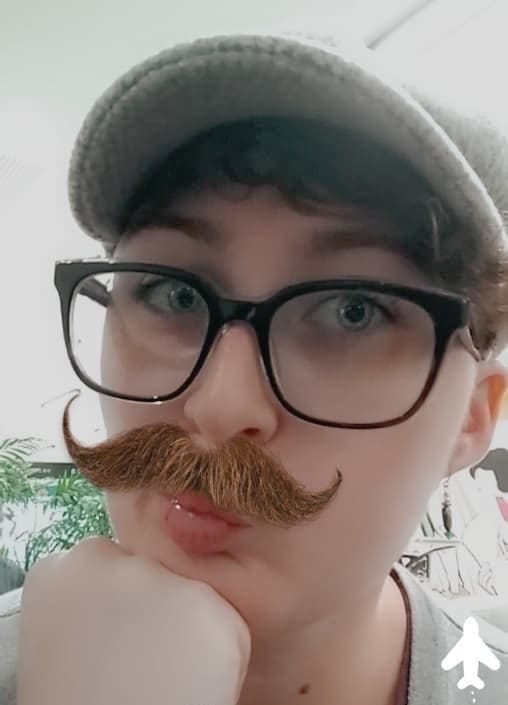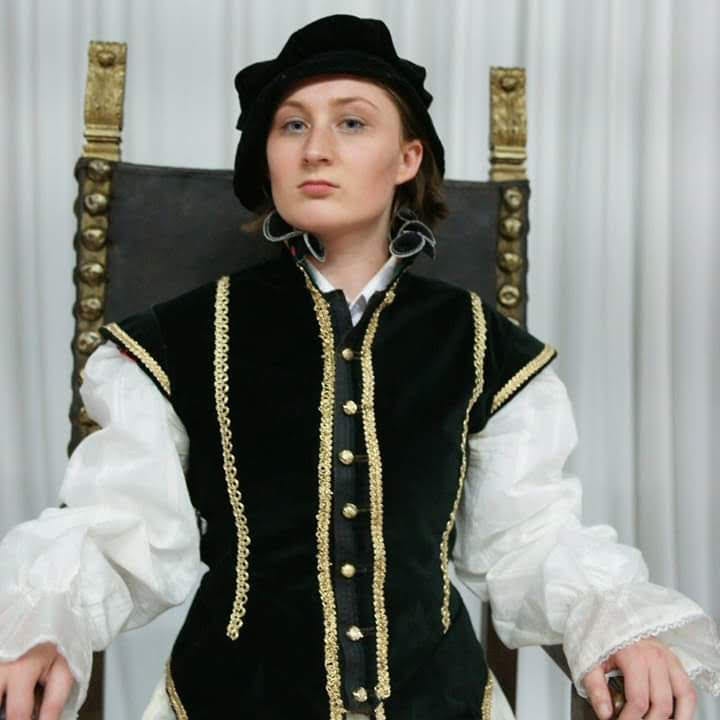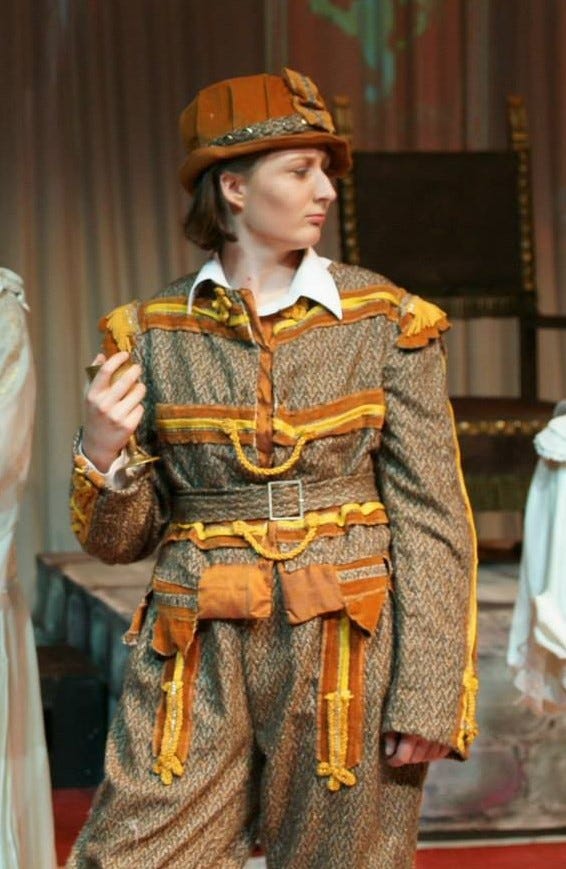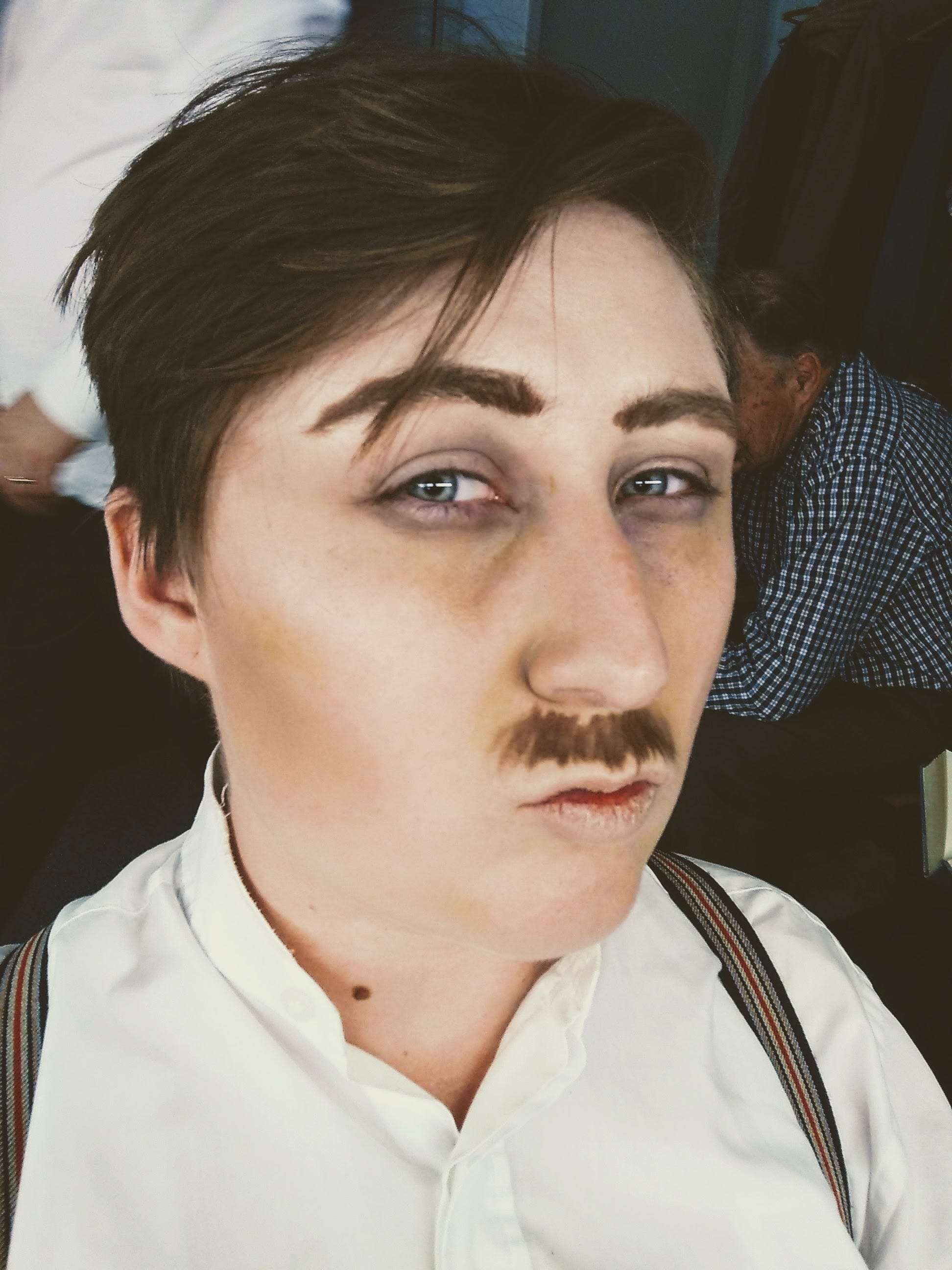On Falsehoods in Gender: an informal essay

This essay was originally written as part of my Master of Writing degree in 2020.
The first hint of my skill as a cross-dresser appeared when I was sixteen. I was in my high school art class, being wildly unproductive—it was the end of the year and we’d finished our portfolios, so the class was essentially a study period for the last term. Which meant, of course, that none of us did any studying whatsoever. Mostly we played cards. On this day, however, we were getting ready for a school event, so I asked one of my friends to paint my face, and gave her carte blanche with the design[1]. When she was finished, I had gained a heart on my cheek, vampire bite marks on my neck, and a moustache above my lip, among other less memorable things. I couldn’t see what I looked like (this was before camera phones took off, or were particularly good), so I turned to another classmate for her verdict on my friend’s handiwork. This second classmate studied me for a moment, then made a wholly unexpected judgement: “You know, you’d make a really hot guy.”
How could I respond to that? The concept of looking either hot or like a guy, let alone both, was quite new to me. But, apparently, I have similar facial structure to Johnny Depp, and in 2009 that counted for something. I replied with some sort of “thanks, I think” comment, and the matter didn’t come up again.
In the years since, I’ve grown much more comfortable with my masculine, “hot-if-I-was-a-guy” features—they’ve turned out to be quite useful to me as an amateur actor. I’ve performed as a lot of different blokes in local community theatre productions over my years of involvement. More men, in fact, than women, which I attribute almost entirely to Richard III, a production in which all seven of my characters were male[2]. I suppose I should have expected something like that if I was going to keep acting in Shakespeare plays.
One of the quirks of English theatre at the time when Shakespeare wrote his plays is that women weren’t allowed to perform on stage. It’s one of the first things you learn in drama classes when you start studying the Bard. Theatres were not known for their propriety, and theatre people were a rowdy bunch[3]. So women, with their oh-so-delicate brains, constitutions, and morals, were confined to the audience. The limited diversity of the casting pool is then reflected in the gender imbalance of Shakespeare’s plays (why do you think the three Weird Sisters in Macbeth are described as bearded?).
He did write some absolutely fantastic and complex female characters, such as Lady Macbeth, Juliet, Goneril and Regan, Rosalind[4], and Cleopatra. The catch is that they’re all big roles. This doesn’t seem to be much of a problem at first, since we actors love having lots of big roles to aspire to. But most of us don’t spring forth onto the stage with the knowledge and skill to play Hamlet or Cleopatra, do we? No, we generally have to start with small roles like the messenger or third-soldier-from-the-left and work our way up. And Shakespeare’s small roles, much like the cast he was writing them for, are overwhelmingly male.

I don’t fit very easily into typical young, female roles from any genre—perhaps it’s the type of energy I give off, my physical awkwardness, or my decidedly un-dainty nose. Whatever the cause, I’m difficult to cast as my actual demographic, and my ability to pose as a passable (and pretty) boy has come in quite handy. I find now that I’m drawn to male roles as well as female ones, and have even started auditioning for them explicitly. I enjoy the freedom that comes with performing men onstage: the freedom to exaggerate myself, to be bigger and louder and more physical and more clownish. Heroines can be noble and kind, or clever and witty, or sexy and cunning, or sweet and demure and honestly a bit airheaded, but my natural inclination isn’t for any of these feminine archetypes. It’s for Arlecchino-type characters.
Some background information is now required. Commedia dell’arte is a form of Italian masked comedy that became popular in the sixteenth century, and has been a major influence in the development of comedic styles throughout Europe ever since. It relies heavily on stock characters that we can still see used in modern comedy: Pantalone, the wealthy old lecher; il Capitano, the arrogant swaggerer who badly needs a punch to the face; the Lovers, who are blind to everyone and everything except each other. One of the most famous of these archetypes is Arlecchino, perhaps known better as the Harlequin[5]. He’s a lower-class character, a sort of everyman, whose ambitions and appetites (for both food and women) constantly land him in trouble. His intentions are for the best, but his lack of foresight and common sense get rather in the way. Arlecchino is a very high-energy and upbeat character, much like I am, and I find his emphasis on physical comedy appealing, even though I am neither coordinated nor athletic enough to pull off many of the acrobatic gags Arlecchino was traditionally known for.
As part of my Theatre and Film Studies (TAFS) major at university, I took a class that focused partially on commedia dell’arte, and for our final end-of-semester assessment we had to devise, in pairs, a short performance in that style. My character for that performance was Arlecchino, he was in love with my scene partner’s character, and he had no idea how to tell her. As we developed our piece, the course tutors coached me to be more and more physically active and exaggerated, and by the end of rehearsals I was spending the entire ten-minute performance running back and forth across the stage on my toes, with my legs bent like a frog’s. Keeping my breathing controlled with all that running became challenging. Sweat dripped down the inside of my papier-mâché mask. As a finale, once I as Arlecchino had finally mustered up the courage to confess my love (much to the beloved’s relief), I picked up my scene partner bridal-style and carried her offstage—slowly, still on my toes, and walking backwards towards our only exit at the back of the stage[6]. My feet ached; my legs trembled. It was the most exhausting performance I’ve ever done in such a short space of time, and it was glorious.
I began playing male roles in high school drama: we only had one boy in the class for the last two years, so quite a few of us donned trouser roles out of necessity. I was also the go-to student for token adult roles (the mothers, the teachers, the middle-aged laudanum addicts), which is more flattering to my acting ability in retrospect than it seemed to be at the time. When I started getting involved with community theatre after high school, I expected to shift from playing almost exclusively blokes and women two or three times my age to acting as nothing but young ladies. I was partially correct. I started getting cast in more female roles, for sure, and the characters were not significantly older than I was[7]. Perplexingly, however, the trouser roles continued. I didn’t think much of it when I was cast as a male soldier for the second half of Julius Caesar—in the first half of the play I was playing women, and the second half is entirely set on the battlefield, so anyone who could be a soldier was drafted. A few years later, that same director handed me a whole bevy of blokes to play in Richard III, and thus my reputation as a cross-dressing actor was born.
Although it had been six years since that first comment about how I would make a hot guy, it wasn’t until I played the Marquess of Dorset in Richard III that I started to see how that might be true. To make myself look more manly for my collection of roles, I added heavy contouring to my face to sharpen the angles of my bones and cut through the feminine softness of my cheeks. As Dorset, I adopted a swaggering confidence that relaxed my posture and twitched my expression into the smirk of an adolescent boy who has inexplicably managed to convince himself that he’s irresistible to women. The result was surprisingly pleasant to look at, even with the muddy-brown, Tudor-style tweed suit and burnt orange corduroy hat[8].

One of the more recent traditions of community theatre is the dressing room selfie. A lot of work by a number of people goes into making actors look good, and we like having our own pictures of the end product to show off. Group selfies are also a great opportunity for cast bonding, as we strike our most fetching or outrageous poses both in and out of character. Some of my favourite pictures of myself show me in male costume—I particularly like the ones of me as Mr Spenalzo (deceased) from Arsenic and Old Lace. I mean, sure, my skin lacks the lustre of the living and my eyes appear to have sunken back into my skull. I am supposed to be playing a dead man, after all. But I have a face that suits facial hair, even when it’s drawn on my face in eyebrow pencil[9]. And the real hair on my head looked fantastic. The play is set in the early 1940s, and since I had no other hair-related commitments I got it cut into a suitable pre-WWII men’s style: short back and sides, and a side part on top (similar to the hairstyle Cary Grant had in the film). As Mr Spenalzo I was not going to be onstage for very long, and the lights were off the whole time I was out there, so the hair was not especially necessary (nor the moustache). However, I never miss a chance to do something new and interesting with my hair (or draw a moustache onto my upper lip).
I get bored with my appearance easily—I have ADHD, so I get bored with everything easily, appearance included—and I’ve discovered that an effective way to sate my desire for novelty is to change my hair. I’d gotten into a pattern through my adolescence where I would grow it out for a couple years, get sick of it and lop it all off, then lose interest in the new style and grow it out again. When my hair became long enough to tie up, I would constantly pull it back so that it would stay out of my face. To my eternal frustration, though, my hair never liked to cooperate with me and would inevitably slip, Houdini-like, out of its elastic constraints to invade my field of vision or tickle the side of my neck.
Although I liked the short styles I picked well enough (mostly bobs, and once a boyish but not entirely flattering pixie cut), I never felt attached enough to them to bother maintaining them once I had them. The Spenalzo hair was the first time I had ever tried a look that was distinctly masculine, and I loved both the look and feel of it far more than I expected to. It felt good to rub my fingers over the soft, closely-trimmed section at the back of my head. It felt good to sweep the longer strands on top of my head into place. It felt really good to look into the mirror and see such a dapper reflection.
Truth be told, the difficulty I have with playing feminine characters is almost certainly rooted in the difficulty I have with performing femininity. I’ve never felt much of a connection with the traditional trappings of womanhood, though I’ve never felt distinctly uncomfortable with them either. I learned the basics of applying make-up, though I didn’t often put these skills to use. The idea was that a bit of lipstick and mascara would make me look prettier, but in practice I just looked very awkward. I would arrive at social occasions with my painted-on smile, self-conscious in a dress that didn’t fit quite right (straps that seized every chance to slip off my shoulders; a too-tight bodice putting gentle, relentless pressure on my ribcage; a neckline low enough to give my bust a hope of busting out; a skirt that seemed modest enough when I stood in front of the mirror in the dressing room, but turned out to be not long enough to stop my thighs from plastering themselves to the chair[10]). With a mask of foundation pulling lightly at my skin and the threat of smearing lipstick on my teeth, I could feel my expressions warping into a sort of grimace instead of a grin. Beautifying my face to go to a party felt just as artificial as a fake moustache but, unlike the moustache, it wasn’t my idea.

As a child, I liked the idea of being a tomboy: a girl who isn’t girly, who hangs out with the boys like she’s one of them (without having to actually be one of the boys). I didn’t make friends with many other girls my age—the ones I did make friends with were as odd as I was—and whatever it was they liked to do with each other was of no interest to me whatsoever. I gave the matter a great deal of thought, but ultimately decided that I couldn’t really call myself a tomboy, because I wasn’t interested in a lot of the “boy” things, like sports or big trucks, any more than the “girl” things.
Although I rejected the tomboy identity, I’ve recently found boyishness seeping out of my stage characters and into my appearance. My work attire is now collared shirts and blazers instead of skirts and tights. Along with the changes in my wardrobe, my hairstyles have also become increasingly androgynous, to the vague disappointment of my mother. Whatever connection I had to traditional womanhood is becoming tenuous and fluid, fading like an old photograph as I pursue a more authentic version of myself.
Gender, like many other facets of personhood, is much more complicated and characteristic than it appears to be on the surface. If I call myself a woman, how much does the statement say about me? What image will you see in your head, and is it anything like the me that exists? I would do better to call myself Rosalind, trouser-clad and boyish, playing with conflicting impressions of masculinity and femininity like it’s a game. Gender is not actually be a game, and for many people it’s vitally serious, but it’s certainly a performance. All the world is, after all, a stage.
[1] Admittedly, this is in most cases a terrible idea when dealing with teenagers, but she was a sensible church friend and I trusted her not to go too far.
[2] Yes, all seven characters were from the same production. Most of them were only in one scene each, so they stacked easily. Nevertheless, I was very busy during that show—between all of my characters I reckon I racked up about as much total stage time as Richard himself.
[3] Not much has changed.
[4] The one from As You Like It, specifically. Rosalinds/Rosalines appear in several of Shakespeare’s works, almost as often as Portias.
[5] In 2011, James Corden performed as a modernised version of Arlecchino in National Theatre’s production of One Man, Two Guv’nors, an adaption of the classic commedia dell’arte play One Servant, Two Masters.
[6] One of the cardinal rules of acting in masks is that you must never turn the mask away from the audience, because doing so will expose the mask’s fastening and break the illusion of the character.
[7] “Significantly”, I say, because in the theatre age is a very fluid concept—in the production of Richard III that I mentioned earlier, the mother of two of my characters was played by an actress of my own age, and Laurence Olivier notoriously cast a woman 14 years his junior to play his mother when he directed and starred in Hamlet in 1948.
[8] It was a costume that was far uglier than anything I would ever choose for myself, but somehow all the more endearing for it. I wore it again in my next show, and would happily break it out for a third time if I get the chance, just for the nostalgia.
[9] It has, so far, always been drawn in eyebrow pencil. When I was nineteen, I asked for a proper false moustache for my soldier in Julius Caesar, but for some reason the director didn’t take me seriously. One day I’ll get one, but in the meantime I’m getting pretty good at drawing facial hair on myself.
[10] I have discovered that anything short of a full-length gown will inevitably be too short to stop my thighs from sticking to chairs. Unfortunately, that is also the perfect length for getting heels caught in my hemline every time I stand up.
If you enjoyed reading about my gender-bending shenanigans, subscribe for free to receive more musings about life, the universe, and everything.
Member discussion